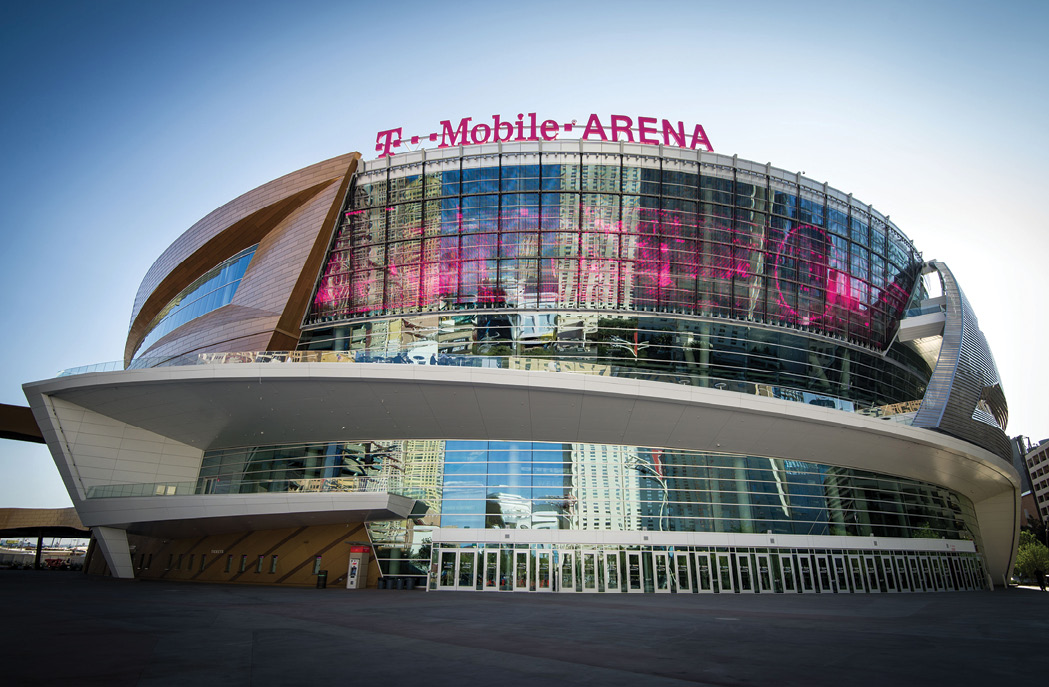
The new T-Mobile Arena in Las Vegas features a complex façade of about 2,790 square meters of insulating glass that was cold-bent onsite. J.E. Berkowitz was the glass fabricator on the project; Quanex supplied the insulating glass spacer system. Photo by J Rick Martin.
The possibilities in architectural glass continue to evolve, with greater complexity, bolder designs and new considerations at every point throughout the manufacturing and glazing process. It’s enough to be a little intimidating, but the opportunity to succeed and to push the boundaries exists and is ripe for the taking.
Whether it’s curved glass, digital printing, oversized panels or any other cutting-edge possibility that has pushed the glass industry toward new frontiers, some of our oldest industry principles still hold water: plan ahead; communicate; and focus on quality and high performance through the efficient use of the resources at our disposal.
But sometimes it’s necessary to go the extra mile. Whether it’s standard flat glass jobs or designs that bend conceptions of what’s possible with glass, here are some other ways to think about achieving quality and success, no matter the job.
Mockup and model
At this year’s 2018 Building Envelope Contractors Conference, I had the opportunity to sit on a panel discussing curved glass with some of the industry’s leading authorities on the subject. One topic discussed on the panel, and one that has come up in more recent conversations I’ve had with industry contacts since, is the value in full-scale mockups for increasingly complex projects. It’s certainly not limited to curved glass—no matter where or how complexity increases in a job, doing the upfront work of a full-scale mockup can help avoid issues downstream.
Taking the extra time—and yes, the extra expense—of this step can help in a couple of ways. First, a full mockup can help ensure the necessary performance targets can and will be achieved once the full project gets underway. Second, a full mockup will help level expectations among all stakeholders in the process, ensuring everyone knows exactly what to expect at the end of the day. By going through this process, no one can say, “That’s not what I expected it to look like.”
Engage early
When dealing with bigger and more complex projects, the number of stakeholders involved only grows. Buy-in from all parties, including architects, consultants, glazing and curtainwall contractors, installers, component suppliers, property owners and more, is important for a successful project, which is all the more reason to involve everyone from the start.
Specifically, I’ve spoken with numerous glazing contractors recently, and I’ve heard a similar refrain crop up. Being involved early on in the design process and being able to contribute advice when it comes to product selection will go a long way in minimizing surprises and ensuring quality of the finished project.
There’s not necessarily a secret to making this happen on every job, of course. But whether you’re a manufacturer, a glazier or play another role in this process, it’s worth making the effort to connect with colleagues and stakeholders in the ways that you’re able. Collaboration is the key to success.
Maintain balance
For glass manufacturers, making new investments in equipment and specialty systems has allowed them to seize new opportunities. Whether it’s new automated systems to handle larger glass, the aforementioned digital printing systems, unique laminates or other specialty systems, it’s important to remember that at the end of the day, our job is to deliver a quality product in an efficient manner.
That’s something we can’t lose sight of, especially as the industry undergoes a period of growth and we’re looking to maximize what’s possible for our business. Aesthetic capabilities continue to increase and demands grow more complex, but remaining focused on delivering thermal performance is just as important a priority.
There are challenges to maintaining the balance, of course. Labor remains an ongoing issue, both on the shop floor and in the field. I’ve spoken to glaziers recently who have been challenged to take on increasingly complex install jobs with a shrinking labor pool.
The commercial glass industry continues exploring new frontiers. When tackling increasingly complex projects and utilizing new technologies to get there, it’s more important than ever to work together as an industry. It will take focus, dedication and ongoing investment to succeed in this evolving market, in our plants, in our people and in our processes. We have the tools—now we need to make the most of them.


